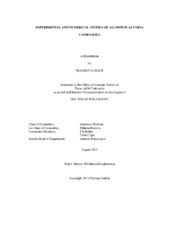| dc.description.abstract | The preliminary goal of this study is to determine the effects of processing conditions, compositions and microstructural morphologies of the constituents on the physical and thermo-mechanical properties of alumina (Al_2O_3) reinforced aluminum (Al) composites. Composites with 0, 5, 10, 20 and 25 vol% Al_2O_3 were manufactured using powder metallurgy method. The elastic properties (Young's and shear modulus) and the coefficient of thermal expansion (CTE) of the composites were determined using Resonant Ultrasound Spectroscopy (RUS) and Thermo Mechanical Analyzer (TMA) respectively at various temperatures. Increasing compacting pressure improved relative density (or lowered porosity) of the composites. Furthermore, increasing the Al_2O_3 vol% in the composite increased the elastic moduli and reduced the CTE of the composites. Increasing the testing temperature from 25 to 450 oC, significantly reduced the elastic moduli of the composites, while the CTE of the composites changed only slightly with temperatures.
Secondly, the goal of this study is to determine the effect of microstructures on the effective thermo-mechanical properties of the manufactured Al-Al_2O_3 composites using finite element (FE) method. Software OOF was used to convert the SEM micrographs of the manufactured composites to FE meshed models, which were then used to determine the effective elastic modulus and CTE. It was observed that, effective modulus dropped by 19.7% when porosity increased by 2.3%; while the effective CTE was mildly affected by the porosity. Additionally, the effect of residual stress on the effective thermo-mechanical properties was studied, and the stress free temperature of the composites was determined.
Another objective of this study is to examine the stress-strain response of Al-Al_2O_3 composites due to compressive loads at various temperatures. Elastic modulus, yield stress and strain hardening parameters were determined from the stress-strain curves and their dependency on temperature, porosity and volume fraction were studied. The experimental results were compared with the numerical results. It was observed that high-localized stresses were present near the pores and at the interfaces between Al and Al_2O_3 constituents.
Finally, functionally graded materials (FGMs) with varying Al_2O_3 concentration (0, 5and 10 vol%) in Al were manufactured; and their stress-strain response and CTE were determined at various temperatures. | en |


